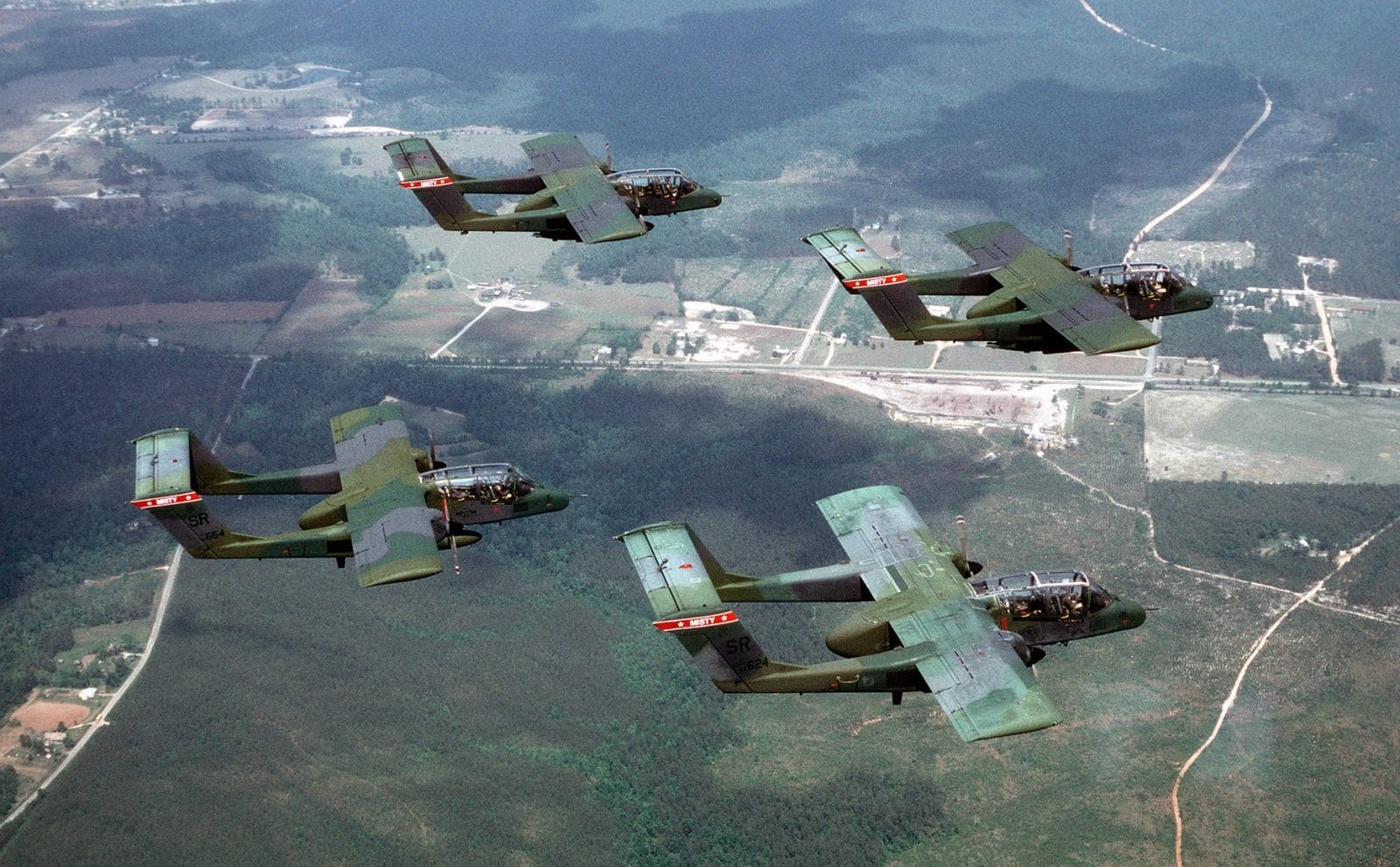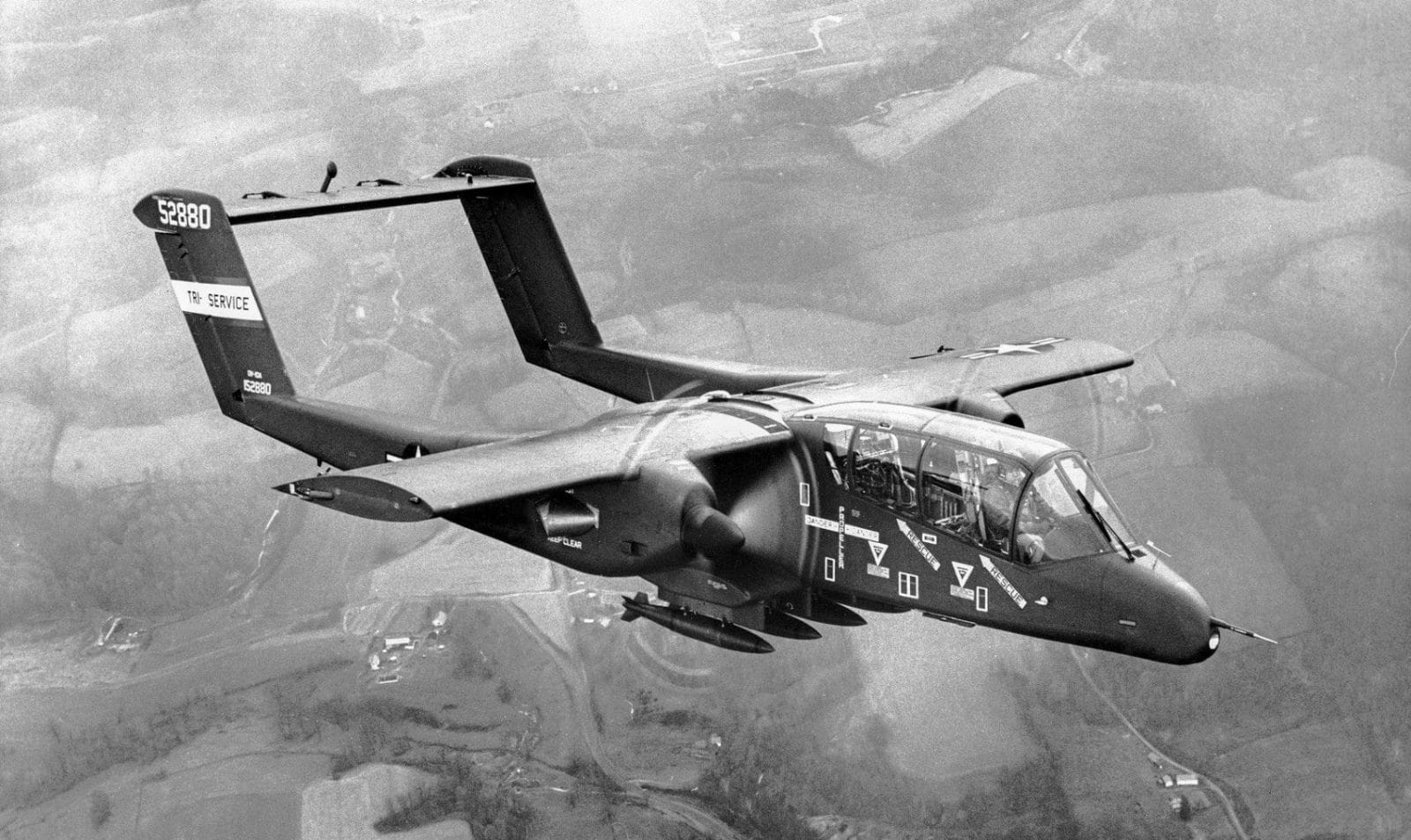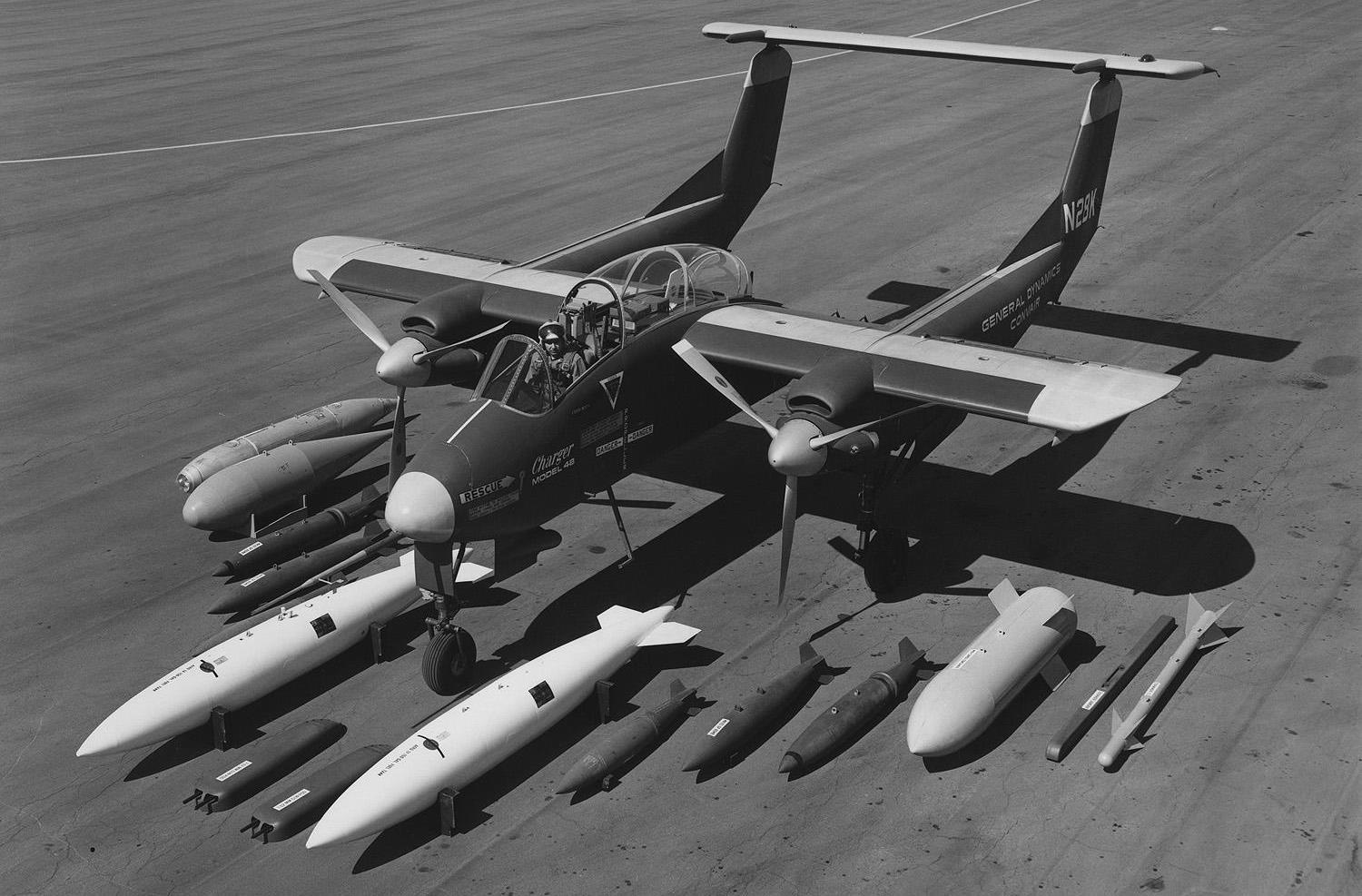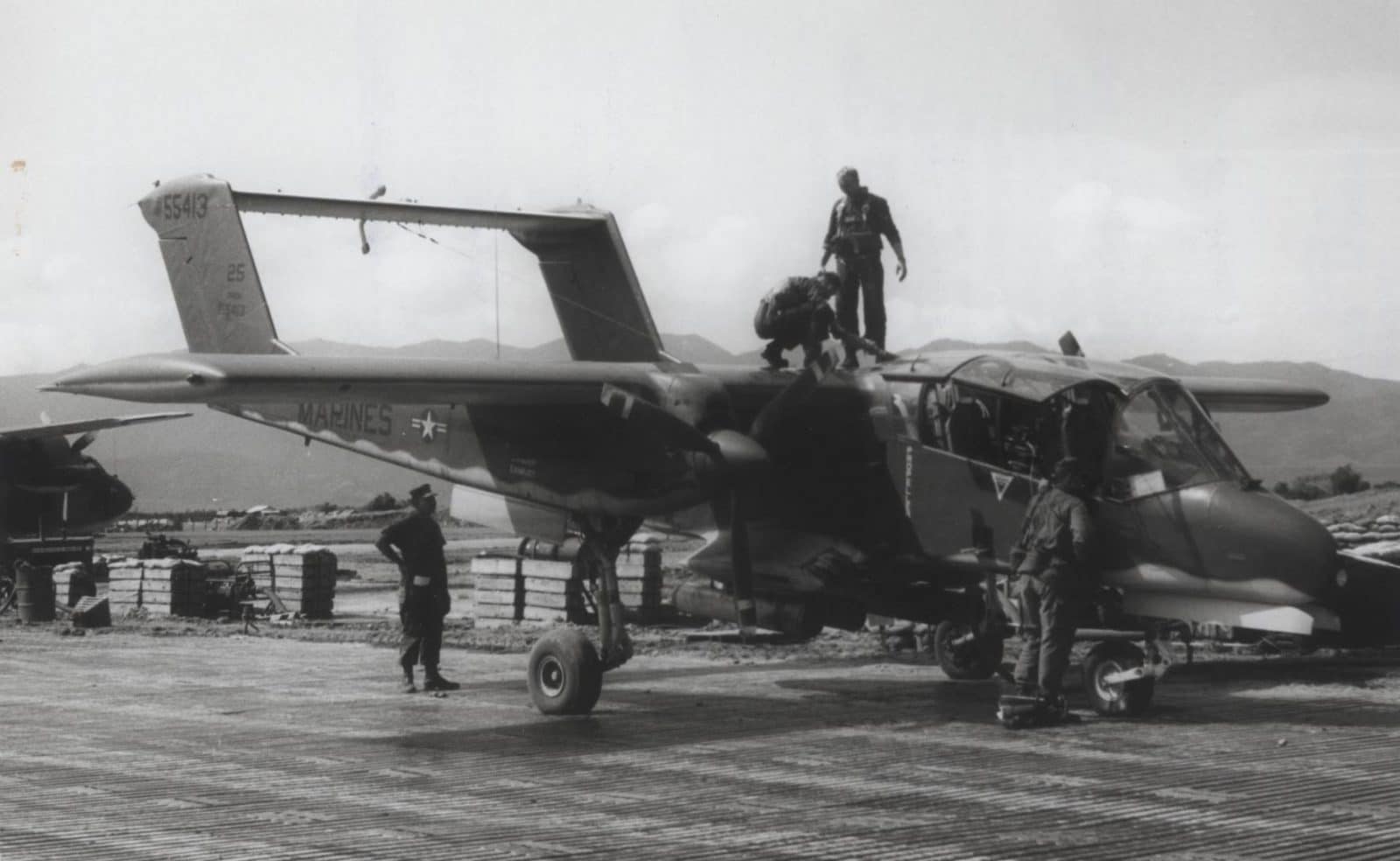Pilots Manned These Trusty Loaded-Down OV-10 Bronco Steeds and Did Battle Down in the Weeds
The story of the OV-10 Bronco actually begins in 1960 with a couple of guys (Marine Corps Majors W.H. Beckett and K.P. Rice) getting together out in the desert and brainstorming a concept study for a small, lightweight, rugged close air support (CAS) aircraft that could be forward deployed with and operated near troops on the ground, capable of extended loiter times, powered by turbine engines, and carry center-mounted internal guns with ordnance carrying flexibility.
Their well-received concept, dubbed VMA, was published and then-Colonel Beckett retired from the Marine Corps and went to work with North American Aircraft (NAA).

A Tough Set of Requirements
Fast forward to 1963. In that year the Light Armed Reconnaissance Aircraft (LARA) specification seemed like an impossible set of requirements. The Tri-Service (Air Force/Navy/Marines) LARA was to be a twin-engine, two place aircraft capable of carrying 2,400 pounds of cargo or six paratroopers or stretchers. In an armed recon aircraft?
It had to be capable of operating from aircraft carriers without any provisions for catapult launch or arrested landing. The LARA was also required to be capable of at least 300 knots (350 miles per hour) airspeed and short takeoff and landing (STOL) performance yielding a takeoff run of 800 feet.

Convertible to an Amphibian?
Also required were flexible armament configurations, beginning with four internal 7.62 millimeter (.30 caliber) machine guns with 500 rounds per gun.
External ordnance requirements included the ability to tote drop tanks, 7.62 and 20 millimeter Gatling gun pods, unguided rocket pods, and even the AIM-9 Sidewinder heat-seeking air-to-air missiles- all this while operating from austere forward bases or roads with minimal heavy maintenance availability. Oh, I almost forgot- The aircraft had to be convertible to an amphibian! The LARA was one tough nut to crack.

Playing the Field
Plenty of companies trotted out LARA contenders though. Grumman proposed a tandem seat derivative of their in-service OV-1 Mohawk. Other proposals included the all-plastic Goodyear GA 39 seaplane fighter with over-wing pod-mounted engines on struts.
The Beechcraft PD-183, Douglas D-855, Helio 1320, and Lockheed CL-760 were all more or less conventional twin engine single tail designs. The Martin proposal was a twin-boom, single-fuselage design with an inverted V tail and exhaust ducted through the booms. The Hiller K16, General Dynamics/Convair Model 48 Charger, and the North American/Rockwell NA-300 were all similar in appearance. In fact the Charger and the NA-300 were very similar aircraft.

North American Wins by a Nose
But the North American NA-300, probably as least in part thanks to the participation of “plank owner” Beckett, won the competition in October of 1964. GD/Convair built a prototype of the Charger under protest of the decision.
The North American NA-300 first flew as the YOV-10A on July 16th 1965. Performance of both aircraft was similar, with the edge actually going to the Charger in some areas. Comparisons between the Charger and what would become the Bronco became moot when the Charger crashed during October of 1965.

Multi-Mission Juggernaut
The Bronco actually resembled the VMA concept except in scale. With a 40 foot wingspan and weighing in at just under 6,900 pounds empty, the Bronco was still a manifestly small aircraft for the time. Missions assigned to the aircraft were armed reconnaissance, forward air control (FAC), tactical airborne observation, ground attack, and helicopter escort (CSAR).
Broncos also flew sorties tasked with artillery and naval gunfire spotting, aerial photography, and aerial radiological reconnaissance. The ability to carry and drop personnel by parachute was utilized many times by various dark agencies referred to by three letter acronyms. LW-3B zero-zero ejection seats and dual flight controls made these trusty Bronco steeds more survivable.

Like Nothing Else in the Skies
Broncos are unmistakable in their appearance. A central nacelle contains the pilots, fixed machine guns located in fuselage mounted sponsons, and the cargo and personnel area aft of the pilots. The two Garrett T76-G-416/417 turboprop engines are mounted forward on the twin booms, with a high-mounted horizontal stabilizer/elevator connecting the vertical stabilizers on the aft ends of each boom.
Broncos carried their ordnance slung under the fuselage or the underwing racks installed later in their careers, including the ubiquitous unguided rocket pods, bombs, various gun pods, flares, and Air Delivered Seismic Intrusion Detector Sensor (ADSIDS) unattended seismic sensors for the Igloo White program.

Internationally Renowned
If the OV-10 Bronco had a deficiency it would be those Garrett turboprop engines. The aircraft was underpowered especially when loaded down with ordnance. Operational ceilings were lower than planned simply because the aircraft couldn’t lug its own weight above about 18,000 feet. Later Bronco variants were powered by uprated engines and pulled along by larger and four-bladed propellers.
In addition to the United States Air Force, Marines, and Navy, the forces of Columbia, Germany, Indonesia, Morocco, the Philippines, Thailand, and Venezuela flew military variants of the OV-10 Bronco. The US Department of State Air Wing, the US Bureau of Land Management, The US Bureau of Alcohol, Tobacco, and Firearms, the National Aeronautics and Space Administration (NASA), and the California Department of Forestry and Fire Protection (Cal-Fire) have flown Broncos as well.


At one point in the early 2000s between five and eight Broncos were updated for State Department work in Hagerstown MD. They midnight blue in color, armor plating below the canopy area. These were originally A model updated to special D models. It has many years so I may have forgotten a few more details